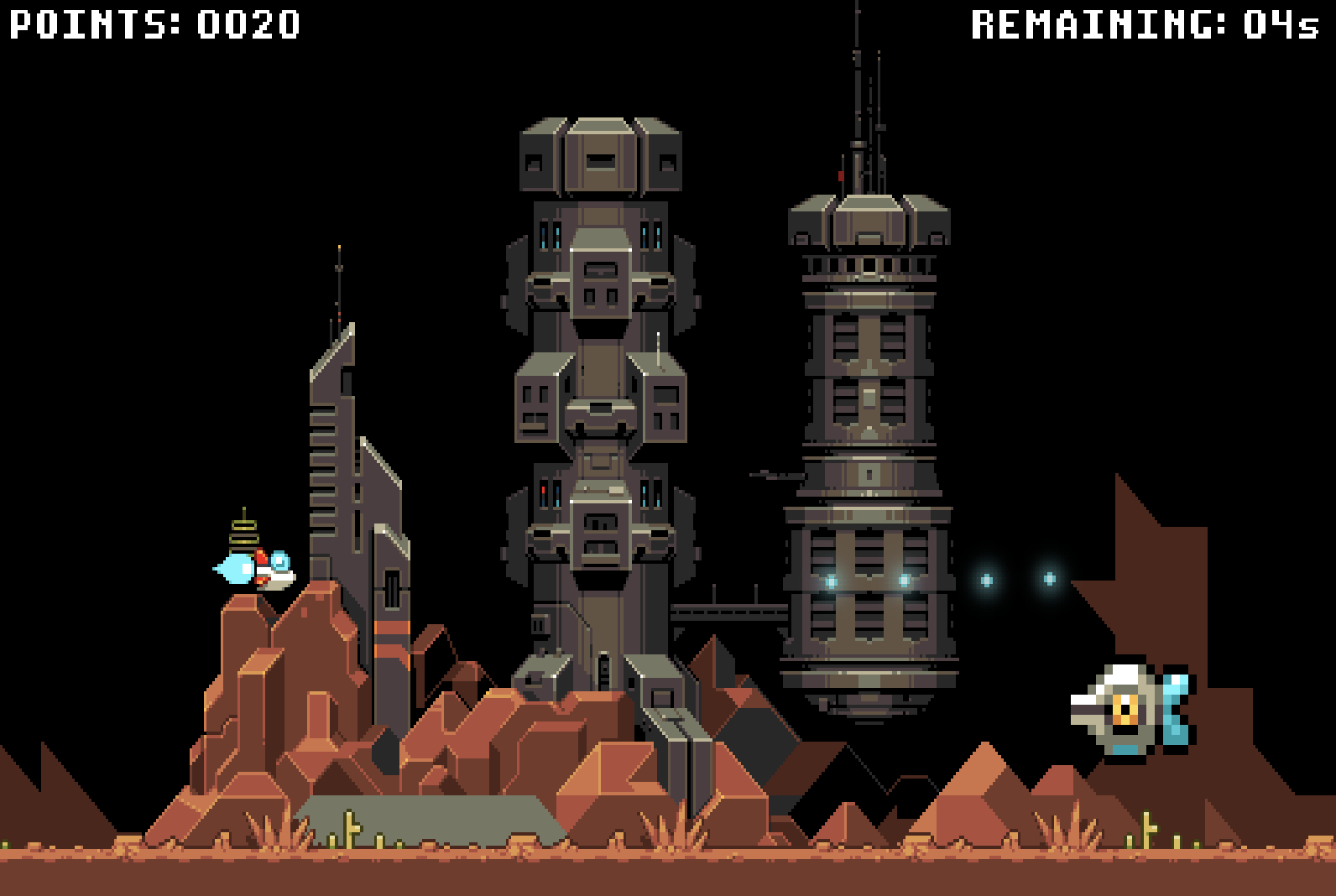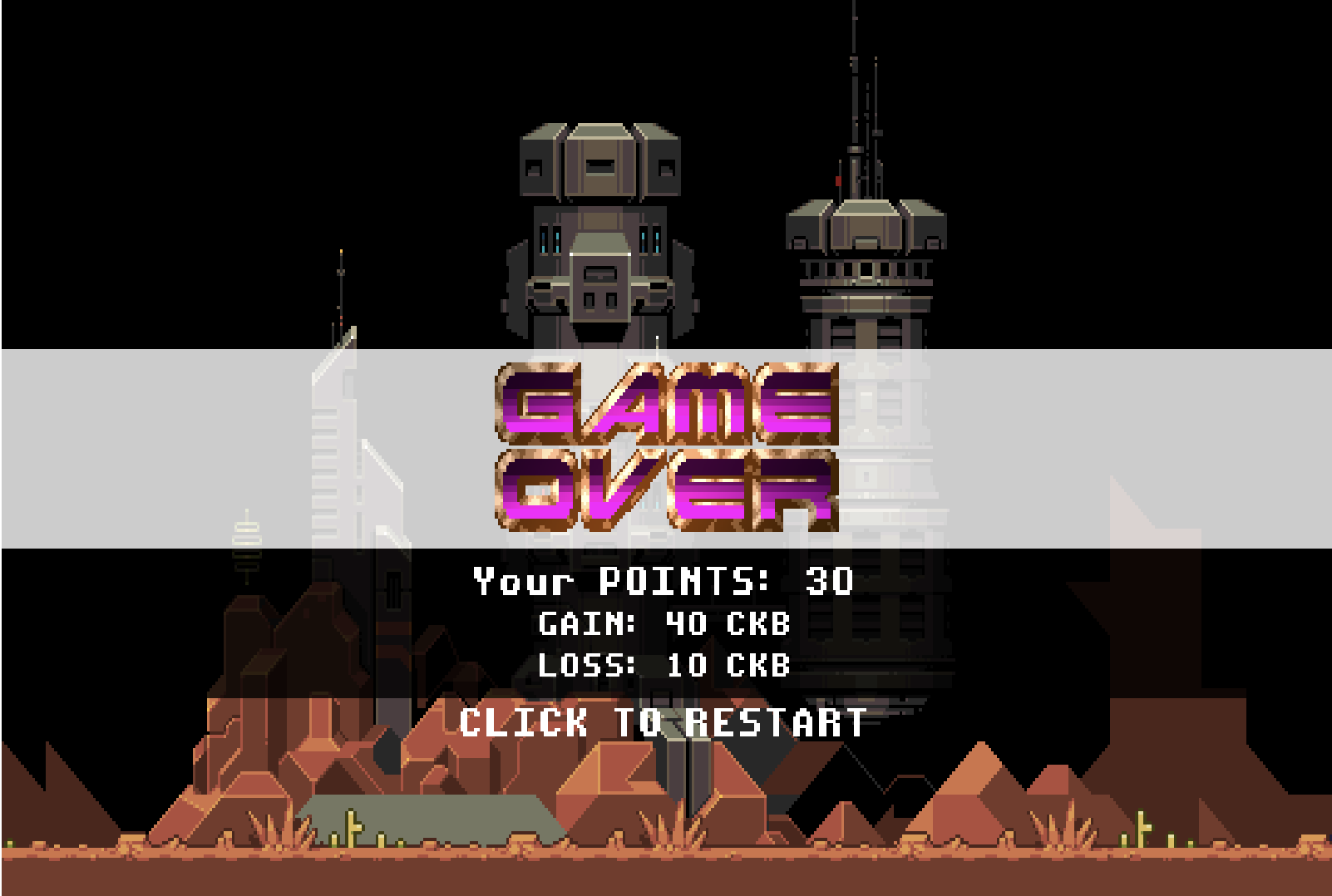Getting Started
Documentation for Fiber Network
This tutorial will guide you through creating a simple Phaser.js game that integrates with the Fiber Testnet. You’ll learn how to implement real-time token transfers within a game environment, enabling instant micro-payments based on in-game actions. This demonstrates how traditional game mechanics can be seamlessly enhanced with blockchain functionality.

The full code of the game can be found in the github repo.
Before getting started, make sure you have:
You need to setup and running two fiber Testnet nodes locally, and make sure they have at least 500 CKB liquidity in their payment channels. It is highly recommended to follow the Run a Fiber Node and Basic Transfer Example guides to set up your nodes first.
In this tutorial, we assume the info for the two nodes are:
#### node1
- peerId: "QmdW4WGRUfqQ8hx92Uaufx4n3TXrJUoDP666BQwbqiDrnv",
- RPC URL: "http://localhost:8227"
- address:
"/ip4/127.0.0.1/tcp/8228/p2p/QmdW4WGRUfqQ8hx92Uaufx4n3TXrJUoDP666BQwbqiDrnv",
#### node2
- peerId: "QmcFpUnjRvMyqbFBTn94wwF8LZodvPWpK39Wg9pYr2i4TQ",
- RPC URL: "http://localhost:8237"
- address:
"/ip4/127.0.0.1/tcp/8238/p2p/QmcFpUnjRvMyqbFBTn94wwF8LZodvPWpK39Wg9pYr2i4TQ",You can change the info to your own nodes in the following steps.
Since the game design is not the focus of this tutorial, we’ll simply take a Phaser.js demo project and integrate the Fiber payment. The demo project can be found in the github repo. It is a simple game with Typescript support that lets you shoot the enemy ship and dodge its attacks to score as many points as possible in a short amount of time.
# git clone the repo
git clone https://github.com/RetricSu/phaser-ts-game-example.git
cd phaser-ts-game-example
# install dependencies
pnpm installNext, let’s edit the vite.config.ts file for bundling our two fiber local nodes since the RPC of nodes is not cors-enabled.
import { defineConfig } from "vite";
import tailwindcss from "@tailwindcss/vite";
export default defineConfig({
base: "./",
plugins: [tailwindcss()],
server: {
proxy: {
"/node1-api": {
target: "http://localhost:8227",
changeOrigin: true,
},
"/node2-api": {
target: "http://localhost:8237",
changeOrigin: true,
},
},
},
});The proxy configuration redirects API calls to your local Fiber nodes. Adjust the ports to match your node configuration.
Most interaction with the Fiber network is done through the RPC API. So let’s create a wrapper for the Fiber RPC API in our typescript project.
We’ll use RequestorJsonRpc from @ckb-ccc/core to help us create the RPC client.
First, install the dependencies:
pnpm add @ckb-ccc/coreThen we’ll create a fiber folder to host all the related code of fiber network in the src folder.
Create a file at src/fiber/rpc.ts and add the FiberRPC class:
import { Hex, RequestorJsonRpc } from "@ckb-ccc/core";
// Interface definitions for Fiber RPC methods
interface ConnectPeerParams {
address: string;
}
interface ListChannelsParams {
peer_id: string;
}
interface NewInvoiceParams {
amount: Hex;
currency: string;
description: string;
expiry: string;
final_cltv: string;
payment_preimage: string;
hash_algorithm?: string;
}
interface SendPaymentParams {
invoice: string;
}
export class FiberRPC {
constructor(private readonly baseUrl: string) {}
/**
* Connect to a peer in the Fiber network
*/
async connectPeer(params: ConnectPeerParams) {
return this.call("connect_peer", [params]);
}
/**
* List channels for a specific peer
*/
async listChannels(params: ListChannelsParams) {
return this.call("list_channels", [params]);
}
/**
* Create a new payment invoice
*/
async newInvoice(params: NewInvoiceParams) {
return this.call("new_invoice", [params]);
}
/**
* Send a payment using an invoice
*/
async sendPayment(params: SendPaymentParams) {
return this.call("send_payment", [params]);
}
/**
* Make a generic RPC call to the Fiber node
*/
private async call(method: string, params: any[]): Promise<any> {
try {
const response = await fetch(this.baseUrl, {
method: "POST",
headers: {
"Content-Type": "application/json",
},
body: JSON.stringify({
id: "1",
jsonrpc: "2.0",
method,
params,
}),
});
if (!response.ok) {
const errorText = await response.text();
throw new Error(`HTTP error! status: ${response.status}, body: ${errorText}`);
}
const result = await response.json();
if (result.error) {
throw new Error(`RPC error: ${JSON.stringify(result.error)}`);
}
return result.result;
} catch (error) {
console.error(`Error calling ${method}:`, error);
throw error;
}
}
}Note: Take Fiber RPC Documentation as reference to implement the FiberRPC class.
Next, create a helper class to manage Fiber node operations at src/fiber/node.ts:
import { Hex } from "@ckb-ccc/core";
import { FiberRPC } from "./rpc";
export class FiberNode {
public readonly rpc: FiberRPC;
constructor(
public readonly url: string,
public readonly peerId: string,
public readonly address: string,
) {
this.rpc = new FiberRPC(url);
}
private generateRandomPaymentImage() {
// use crypto to generate a 32 byte random hash
const paymentHash = crypto.getRandomValues(new Uint8Array(32));
return (
"0x" +
Array.from(paymentHash)
.map((b) => b.toString(16).padStart(2, "0"))
.join("")
);
}
async createCKBInvoice(amount: Hex, description: string) {
const paymentImage = this.generateRandomPaymentImage();
return await this.rpc.newInvoice({
amount,
currency: "Fibt",
description,
expiry: "0xe10",
final_cltv: "0x28",
payment_preimage: paymentImage,
});
}
async sendPayment(invoice: string) {
return await this.rpc.sendPayment({
invoice,
});
}
}Now, create the main Fiber integration file at src/fiber/index.ts:
import { Hex } from "@ckb-ccc/core";
import { FiberNode } from "./node";
export const amountPerPoint = 1 * 10 ** 8; // 1 CKB per point
const node1 = {
peerId: "QmdW4WGRUfqQ8hx92Uaufx4n3TXrJUoDP666BQwbqiDrnv",
address:
"/ip4/127.0.0.1/tcp/8228/p2p/QmdW4WGRUfqQ8hx92Uaufx4n3TXrJUoDP666BQwbqiDrnv",
url: "/node1-api",
};
const node2 = {
peerId: "QmcFpUnjRvMyqbFBTn94wwF8LZodvPWpK39Wg9pYr2i4TQ",
address:
"/ip4/127.0.0.1/tcp/8238/p2p/QmcFpUnjRvMyqbFBTn94wwF8LZodvPWpK39Wg9pYr2i4TQ",
url: "/node2-api",
};
export async function prepareNodes() {
const bossNode = new FiberNode(node1.url, node1.peerId, node1.address);
const playerNode = new FiberNode(node2.url, node2.peerId, node2.address);
console.log("bossNode", bossNode);
console.log("playerNode", playerNode);
await bossNode.rpc.connectPeer({
address: playerNode.address,
});
const myChannels = await bossNode.rpc.listChannels({
peer_id: playerNode.peerId,
});
const activeChannel = myChannels.channels.filter(
(channel) => channel.state.state_name === "CHANNEL_READY",
);
console.log("activeChannel", activeChannel);
return { bossNode, playerNode };
}
export async function payPlayerPoints(
bossNode: FiberNode,
playerNode: FiberNode,
points: number,
) {
const amount: Hex = `0x${(amountPerPoint * points).toString(16)}`;
const invoice = await playerNode.createCKBInvoice(
amount,
"player hit the boss!",
);
const result = await bossNode.sendPayment(invoice.invoice_address);
console.log(`boss pay player ${points} CKB`);
console.log("invoice", invoice);
console.log("payment result", result);
}
export async function payBossPoints(
bossNode: FiberNode,
playerNode: FiberNode,
points: number,
) {
const amount: Hex = `0x${(amountPerPoint * points).toString(16)}`;
const invoice = await bossNode.createCKBInvoice(
amount,
"boss hit the player!",
);
const result = await playerNode.sendPayment(invoice.invoice_address);
console.log(`player pay boss ${points} CKB`);
console.log("invoice", invoice);
console.log("payment result", result);
}
Pay attention to the payPlayerPoints and payBossPoints functions — they handle CKB payments between players when the player hits the enemy ship or when the boss hits the player.
We defined that payment rate as 1 CKB per point in amountPerPoint, meaning that if the player score 10 points, the boss will pay 10 CKB to the player and vice versa. All payments are made in real-time through the Fiber network.
Now that the Fiber integration is set up, let’s integrate it with our Phaser.js game.
The main file to edit is src/scenes/MainScene.ts. We’ll start by adding some properties in the MainScene class to host the Fiber nodes and track the score.
+ import { prepareNodes, payPlayerPoints, payBossPoints } from "../fiber";
export class MainScene extends Scene {
player: Player | null = null;
enemy_blue: BlueEnemy | null = null;
cursors!: Types.Input.Keyboard.CursorKeys;
+ bossNode: any = null;
+ playerNode: any = null;
+ bossPoints: number = 0;
+ playerPoints: number = 0;Next, we need to initialize the Fiber nodes and the score in the init function. Note that init needs to be changed to an async function so that we can await for the Fiber nodes initialization.
async init(): Promise<void> {
this.cameras.main.fadeIn(1000, 0, 0, 0);
this.scene.launch("MenuScene");
// Reset points
this.points = 0;
this.bossPoints = 0;
this.playerPoints = 0;
this.game_over_timeout = 20;
// Initialize Fiber nodes
try {
const { bossNode, playerNode } = await prepareNodes();
this.bossNode = bossNode;
this.playerNode = playerNode;
console.log("Fiber nodes initialized successfully");
} catch (error) {
console.error("Failed to initialize Fiber nodes:", error);
}
}Next, let’s look at the setupCollisions function. We need to pay CKB to the player when the player hits the enemy ship, and to the boss when the boss hits the player.
setupCollisions(): void {
// ...existing code...
// Overlap enemy with bullets
// ...existing code...
typedBullet.destroyBullet();
this.enemy_blue.damage(this.player.x, this.player.y);
this.points += 10;
this.playerPoints += 10;
// Call payPlayerPoints when player hits enemy
if (this.bossNode && this.playerNode) {
try {
await payPlayerPoints(
this.bossNode,
this.playerNode,
10,
);
} catch (error) {
console.error("Failed to score point:", error);
}
}
// existing code...
// Overlap player with enemy bullets
// existing code...
this.points -= 10;
this.bossPoints += 10;
// Call payBossPoints when enemy hits player
if (this.bossNode && this.playerNode) {
try {
await payBossPoints(
this.bossNode,
this.playerNode,
10,
);
} catch (error) {
console.error(
"Failed to process lose point:",
error,
);
}
}In case you need the full code of the MainScene:
import { Scene, Input, Types } from "phaser";
import { Player } from "../gameobjects/Player";
import { BlueEnemy } from "../gameobjects/BlueEnemy";
import { Bullet } from "../gameobjects/Bullet";
import { prepareNodes, payPlayerPoints, payBossPoints } from "../fiber";
export class MainScene extends Scene {
player: Player | null = null;
enemy_blue: BlueEnemy | null = null;
cursors!: Types.Input.Keyboard.CursorKeys;
bossNode: any = null;
playerNode: any = null;
bossPoints: number = 0;
playerPoints: number = 0;
points: number = 0;
game_over_timeout: number = 20;
constructor() {
super("MainScene");
}
async init(): Promise<void> {
this.cameras.main.fadeIn(1000, 0, 0, 0);
this.scene.launch("MenuScene");
// Reset points
this.points = 0;
this.bossPoints = 0;
this.playerPoints = 0;
this.game_over_timeout = 20;
// Initialize Fiber nodes
try {
const { bossNode, playerNode } = await prepareNodes();
this.bossNode = bossNode;
this.playerNode = playerNode;
console.log("Fiber nodes initialized successfully");
} catch (error) {
console.error("Failed to initialize Fiber nodes:", error);
}
}
create(): void {
this.add.image(0, 0, "background").setOrigin(0, 0);
this.add.image(0, this.scale.height, "floor").setOrigin(0, 1);
// Player
this.player = new Player({ scene: this });
// Enemy
this.enemy_blue = new BlueEnemy(this);
// Cursor keys
this.setupControls();
// Setup collisions
this.setupCollisions();
// This event comes from MenuScene
this.game.events.on("start-game", () => {
this.scene.stop("MenuScene");
this.scene.launch("HudScene", {
remaining_time: this.game_over_timeout,
});
if (this.player) {
this.player.start();
}
if (this.enemy_blue) {
this.enemy_blue.start();
}
// Game Over timeout
this.time.addEvent({
delay: 1000,
loop: true,
callback: () => {
if (this.game_over_timeout === 0) {
// You need remove the event listener to avoid duplicate events.
this.game.events.removeListener("start-game");
// It is necessary to stop the scenes launched in parallel.
this.scene.stop("HudScene");
this.scene.start("GameOverScene", {
points: this.points,
playerPoints: this.playerPoints,
bossPoints: this.bossPoints,
});
} else {
this.game_over_timeout--;
const hudScene = this.scene.get("HudScene");
if (
hudScene &&
typeof (hudScene as any).update_timeout ===
"function"
) {
(hudScene as any).update_timeout(
this.game_over_timeout,
);
}
}
},
});
});
}
setupControls(): void {
this.cursors = this.input.keyboard.createCursorKeys();
// @ts-ignore - We know this.cursors is not null at this point
this.cursors.space.on("down", () => {
if (this.player) {
this.player.fire();
}
});
this.input.on("pointerdown", (pointer: Input.Pointer) => {
if (this.player) {
this.player.fire(pointer.x, pointer.y);
}
});
}
setupCollisions(): void {
// Overlap enemy with bullets
if (this.player && this.enemy_blue) {
this.physics.add.overlap(
this.player.bullets,
this.enemy_blue,
async (_enemy, bullet) => {
const typedBullet = bullet as unknown as Bullet;
if (
typedBullet.destroyBullet &&
this.player &&
this.enemy_blue
) {
typedBullet.destroyBullet();
this.enemy_blue.damage(this.player.x, this.player.y);
this.points += 10;
this.playerPoints += 10;
// Call payPlayerPoints when player hits enemy
if (this.bossNode && this.playerNode) {
try {
await payPlayerPoints(
this.bossNode,
this.playerNode,
10,
);
} catch (error) {
console.error("Failed to score point:", error);
}
}
const hudScene = this.scene.get("HudScene");
if (
hudScene &&
typeof (hudScene as any).update_points ===
"function"
) {
(hudScene as any).update_points(this.points);
}
}
},
);
// Overlap player with enemy bullets
this.physics.add.overlap(
this.enemy_blue.bullets,
this.player,
async (_player, bullet) => {
const typedBullet = bullet as unknown as Bullet;
if (typedBullet.destroyBullet) {
typedBullet.destroyBullet();
this.cameras.main.shake(100, 0.01);
this.cameras.main.flash(300, 255, 10, 10, false);
this.points -= 10;
this.bossPoints += 10;
// Call payBossPoints when enemy hits player
if (this.bossNode && this.playerNode) {
try {
await payBossPoints(
this.bossNode,
this.playerNode,
10,
);
} catch (error) {
console.error(
"Failed to process lose point:",
error,
);
}
}
const hudScene = this.scene.get("HudScene");
if (
hudScene &&
typeof (hudScene as any).update_points ===
"function"
) {
(hudScene as any).update_points(this.points);
}
}
},
);
}
}
update(): void {
if (this.player) {
this.player.update();
}
if (this.enemy_blue) {
this.enemy_blue.update();
}
// Player movement entries
if (this.player) {
if (this.cursors.up.isDown) {
this.player.move("up");
}
if (this.cursors.down.isDown) {
this.player.move("down");
}
}
}
}The GameOverScene is the scene that will be launched when the game is over.
The original code only display the final scoring points of the player.
We need to display the earn/lose CKB amount to the scene too.
import { Scene } from "phaser";
interface GameOverSceneInitData {
points?: number;
playerPoints?: number;
bossPoints?: number;
}
export class GameOverScene extends Scene {
end_points: number = 0;
player_points: number = 0;
boss_points: number = 0;
constructor() {
super("GameOverScene");
}
init(data: GameOverSceneInitData): void {
this.cameras.main.fadeIn(1000, 0, 0, 0);
this.end_points = data.points || 0;
this.player_points = data.playerPoints || 0;
this.boss_points = data.bossPoints || 0;
}
create(): void {
// Backgrounds
this.add.image(0, 0, "background").setOrigin(0, 0);
this.add.image(0, this.scale.height, "floor").setOrigin(0, 1);
// Rectangles to show the text
// Background rectangles
this.add
.rectangle(
0,
this.scale.height / 2,
this.scale.width,
120,
0xffffff,
)
.setAlpha(0.8)
.setOrigin(0, 0.5);
this.add
.rectangle(
0,
this.scale.height / 2 + 105,
this.scale.width,
90,
0x000000,
)
.setAlpha(0.8)
.setOrigin(0, 0.5);
const gameover_text = this.add.bitmapText(
this.scale.width / 2,
this.scale.height / 2,
"knighthawks",
"GAME\nOVER",
62,
1,
);
gameover_text.setOrigin(0.5, 0.5);
gameover_text.postFX.addShine();
this.add
.bitmapText(
this.scale.width / 2,
this.scale.height / 2 + 85,
"pixelfont",
`Your POINTS: ${this.end_points}`,
24,
)
.setOrigin(0.5, 0.5);
this.add
.bitmapText(
this.scale.width / 2,
this.scale.height / 2 + 110,
"pixelfont",
`GAIN: ${this.player_points} CKB`,
20,
)
.setOrigin(0.5, 0.5);
this.add
.bitmapText(
this.scale.width / 2,
this.scale.height / 2 + 135,
"pixelfont",
`LOSS: ${this.boss_points} CKB`,
20,
)
.setOrigin(0.5, 0.5);
this.add
.bitmapText(
this.scale.width / 2,
this.scale.height / 2 + 170,
"pixelfont",
"CLICK TO RESTART",
24,
)
.setOrigin(0.5, 0.5);
// Click to restart
this.time.addEvent({
delay: 1000,
callback: () => {
this.input.on("pointerdown", () => {
this.scene.start("MainScene");
});
},
});
}
}
All good now! Let’s run your game!
pnpm devBefore running your game, make sure your Fiber nodes are running and have an open payment channel between them. You can follow the Run a Fiber Node and Basic Transfer Example guides to set up your nodes.
If everything is set up correctly, you should be able to click and play the game like this:

Open the browser console to view the payment logs. When the game is over, you’ll see the final scores along with the payment info, like this:

In this tutorial, you’ve learned how to integrate the Fiber network with a Phaser.js game to enable real-time token transfers based on in-game actions. This approach opens up new possibilities for blockchain-based gaming, including:
By leveraging Fiber’s Layer 2 scaling solution, you can build games with blockchain features that don’t compromise on user experience or performance.
For a production environment and more advanced use cases, consider implementing:
Happy coding, and enjoy building your blockchain-enabled games!